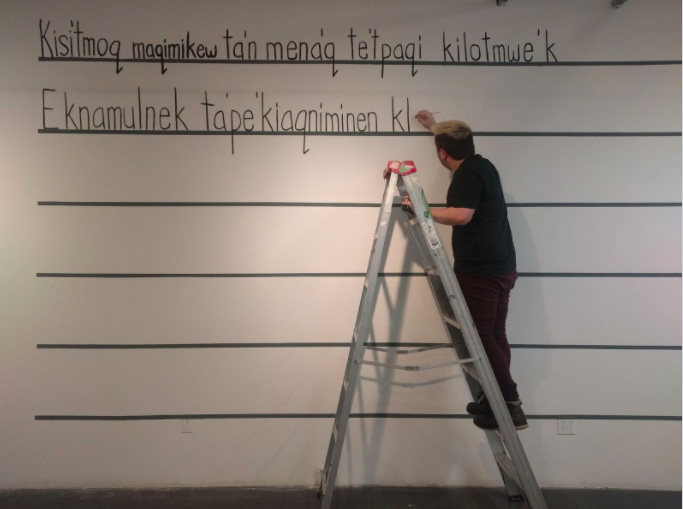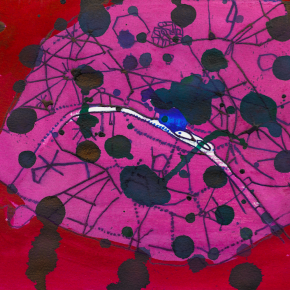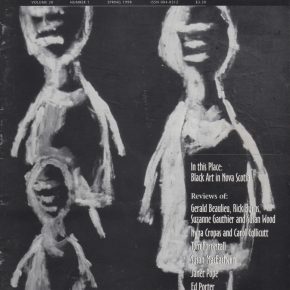
Eastern Edge Gallery’s assistant director Daniel Rumbolt transcribes text sent via instant messaging from artists Ursula Johnson and Jordan Bennett on the wall. Courtesy of Eastern Edge Gallery
When Jordan Bennett was an artist in residence at Winnipeg’s Plug In Institute of Contemporary Art, Ursula Johnson would send him daily Mi’kmaq words via instant messaging. The artists’ Mi’kmaq Word of the Day 2.0, showing at Eastern Edge Gallery in St. John’s from February 5-April 25 2017, is a reimagining of that earlier collaborative work. This time out, the work consists of daily phrases or parts of sentences the artists send via instant message to Eastern Edge, at which point gallery staff transcribe the words on the wall. At the end of the exhibition, these lines of text will form a message to the gallery-going public in Mi’kmaq.
A couple of speakers opposite the text emit the sound of a voice which repeats that particular day’s phrase in English so that the gallery visitor is left to puzzle together how the wall text is being formed and what it may eventually say. The invitation on the artists’ behalf to visit the gallery every day is integral to appreciating the meaning of the work: a gallery visitor will see how the text expands and grows, the sound component changes, the message written on the walls becoming clearer as time moves on. This goes directly to the heart of not just how (obviously) the work is completed in abstentia by the artists, but, likewise, to the gradual and incremental nature of political and social change. Not to mention the nature of artistic practice itself: piecemeal, slowly and without a necessarily known outcome or endpoint, if any.
There’s an otherworldly or ghostly quality to the installation—the spare gallery space suggesting something more akin to absence—an absence that diminishes as the text slowly spreads day by day across the walls of the gallery. That the work in question is installed in Ktaqmkuk (Newfoundland), the site of what some consider the only successful campaign of genocide in the history of humankind, speaks directly to the notion of contemporary and historical trauma made manifest in the gallery space. Nearly the entire indigenous Beothuk population had perished by the early 1800s,following the influx of European settlers [Newfoundland doesn’t endorse use of the word “genocide.”] Johnson and Bennett’s work, even if considered only as a rhetorical gesture, embodies the tension between the attempted erasure and annihilation of a culture through language and technology, with the continued resistance to that erasure.
Their work is a fitting metaphor for the original and ongoing white- washing of Indigenous language and culture in our society at large and artistic culture in particular in Canada—the slowly creeping text indicating a gradual re-emergence of this marginalized culture in a way that recalls the land’s ability to recover from environmental trauma. Or, for that matter, how the politically dispossessed inscribe the language of their resistance upon the walls of dominant cultural orthodoxy. Smarter people than me have written at length about this topic, so I’ll just say the installation compellingly addresses the almost imperceptible ways (at least to this privileged reviewer) in which a particular voice is silenced.
The work neatly intersects where ancient spoken language and the ephemeral nature of contemporary communications come together. It occupies a space that synthesizes the history of an oral tradition slowly handed down generation after generation with the culture of text and instant messaging—a form of communication and a distinct language itself that is never more than a “delete history” click away from being lost forever—unless you’ve backed things up. The installation succinctly describes the paradox: a long enduring Indigenous language, steeped in a culture of survival through bloodshed and genocide, is threatened by, and yet thrives through, the sound and fury of modern technology.
















Leave a Reply